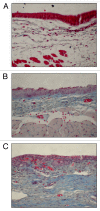Hyaluronic acid hydrogels for vocal fold wound healing
- PMID: 23507923
- PMCID: PMC3732321
- DOI: 10.4161/biom.23799
Hyaluronic acid hydrogels for vocal fold wound healing
Abstract
The unique vibrational properties inherent to the human vocal fold have a significant detrimental impact on wound healing and scar formation. Hydrogels have taken prominence as a tissue engineered strategy to restore normal vocal structure and function as cellularity is low. The frequent vibrational and shear forces applied to, and present in this connective tissue make mechanical properties of such hydrogels a priority in this active area of research. Hyaluronic acid has been chemically modified in a variety of ways to address cell function while maintaining desirable tissue mechanical properties. These various modifications have had mixed results when injected in vivo typically resulting in better biomechanical function but not necessarily with a concomitant decrease in tissue fibrosis. Recent work has focused on seeding mesenchymal progenitor cells within 3D architecture of crosslinked hydrogels. The data from these studies demonstrate that this approach has a positive effect on cells in both early and late wound healing, but little work has been done regarding the biomechanical effects of these treatments. This paper provides an overview of the various hyaluronic acid derivatives, their crosslinking agents, and their effect when implanted into the vocal folds of various animal models.
Keywords: hyaluronic acid hydrogel; progenitor cell; tissue engineering; vocal fold.
Figures



Similar articles
-
Adipose-derived stem cell-containing hyaluronic acid/alginate hydrogel improves vocal fold wound healing.Laryngoscope. 2014 Mar;124(3):E64-72. doi: 10.1002/lary.24405. Epub 2013 Oct 22. Laryngoscope. 2014. PMID: 24115025
-
In vivo engineering of the vocal fold extracellular matrix with injectable hyaluronic acid hydrogels: early effects on tissue repair and biomechanics in a rabbit model.Ann Otol Rhinol Laryngol. 2005 Sep;114(9):662-70. doi: 10.1177/000348940511400902. Ann Otol Rhinol Laryngol. 2005. PMID: 16240927
-
Hyaluronan Hydrogels for the Local Delivery of Mesenchymal Stromal Cells to the Injured Vocal Fold.Stem Cells Dev. 2019 Sep 1;28(17):1177-1190. doi: 10.1089/scd.2019.0102. Epub 2019 Jul 29. Stem Cells Dev. 2019. PMID: 31244387
-
A Review of Hyaluronic Acid and Hyaluronic Acid-based Hydrogels for Vocal Fold Tissue Engineering.J Voice. 2017 Jul;31(4):416-423. doi: 10.1016/j.jvoice.2016.11.014. Epub 2017 Mar 2. J Voice. 2017. PMID: 28262503 Free PMC article. Review.
-
Vocal fold wound healing: a review for clinicians.J Voice. 2006 Sep;20(3):432-42. doi: 10.1016/j.jvoice.2005.08.005. Epub 2005 Dec 1. J Voice. 2006. PMID: 16324825 Review.
Cited by
-
Biocompatibility and Viscoelastic Properties of Injectable Resilin-Like Polypeptide and Hyaluronan Hybrid Hydrogels in Rabbit Vocal Folds.Regen Eng Transl Med. 2019 Dec;5(4):373-386. doi: 10.1007/s40883-019-00094-6. Epub 2019 Feb 27. Regen Eng Transl Med. 2019. PMID: 33829078 Free PMC article.
-
Incorporation of types I and III collagen in tunable hyaluronan hydrogels for vocal fold tissue engineering.Acta Biomater. 2019 Mar 15;87:97-107. doi: 10.1016/j.actbio.2019.01.058. Epub 2019 Jan 30. Acta Biomater. 2019. PMID: 30708064 Free PMC article.
-
Investigation of Changes in Saliva in Radiotherapy-Induced Head Neck Cancer Patients.Int J Environ Res Public Health. 2021 Feb 9;18(4):1629. doi: 10.3390/ijerph18041629. Int J Environ Res Public Health. 2021. PMID: 33572065 Free PMC article.
-
Liquid-type plasma-controlled in situ crosslinking of silk-alginate injectable gel displayed better bioactivities and mechanical properties.Mater Today Bio. 2022 Jun 10;15:100321. doi: 10.1016/j.mtbio.2022.100321. eCollection 2022 Jun. Mater Today Bio. 2022. PMID: 35757030 Free PMC article.
-
Pathophysiology of Fibrosis in the Vocal Fold: Current Research, Future Treatment Strategies, and Obstacles to Restoring Vocal Fold Pliability.Int J Mol Sci. 2019 May 24;20(10):2551. doi: 10.3390/ijms20102551. Int J Mol Sci. 2019. PMID: 31137626 Free PMC article. Review.
References
-
- Smith E, Verdolini K, Gray SD, Nichols S, Lemke J. Effect of voice disorders on quality of life. J Med Speech-Lang Pathol. 1996;4:223–44.
Publication types
MeSH terms
Substances
Grants and funding
LinkOut - more resources
Full Text Sources
Other Literature Sources
